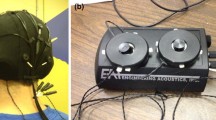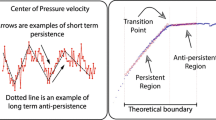Abstract
When maintaining postural stability temporally under increased sensory conflict, a more rigid response is used where the available degrees of freedom are essentially frozen. The current study investigated if such a strategy is also utilized during more dynamic situations of postural control as is the case with walking. This study attempted to answer this question by using the Locomotor Sensory Organization Test (LSOT). This apparatus incorporates SOT inspired perturbations of the visual and the somatosensory system. Ten healthy young adults performed the six conditions of the traditional SOT and the corresponding six conditions on the LSOT. The temporal structure of sway variability was evaluated from all conditions. The results showed that in the anterior posterior direction somatosensory input is crucial for postural control for both walking and standing; visual input also had an effect but was not as prominent as the somatosensory input. In the medial lateral direction and with respect to walking, visual input has a much larger effect than somatosensory input. This is possibly due to the added contributions by peripheral vision during walking; in standing such contributions may not be as significant for postural control. In sum, as sensory conflict increases more rigid and regular sway patterns are found during standing confirming the previous results presented in the literature, however the opposite was the case with walking where more exploratory and adaptive movement patterns are present.





Similar content being viewed by others
Abbreviations
- LSOT:
-
Locomotor Sensory Organization Test
- SOT:
-
Sensory Organization Test
- netCOP:
-
net Center of Pressure
- SampEn:
-
Sample Entropy
References
Abasolo, D., James, C. J., and Hornero, R. Non-linear analysis of intracranial electroencephalogram recordings with approximate entropy and Lempel-Ziv complexity for epileptic seizure detection. Conference Proceedings: Annual International Conference of the IEEE Engineering in Medicine and Biology Society, 2007, pp. 1953–1956.
Black, F. O., C. L. Shupert, F. B. Horak, and L. M. Nashner. Abnormal postural control associated with peripheral vestibular disorders. Prog. Brain Res. 76:263–275, 1988.
Borg, F. G., and G. Laxaback. Entropy of balance—some recent results. J. Neuroeng. Rehabil. 7:38, 2010.
Cavanaugh, J. T., K. M. Guskiewicz, C. Giuliani, S. Marshall, V. Mercer, and N. Stergiou. Detecting altered postural control after cerebral concussion in athletes with normal postural stability. Br. J. Sports Med. 9(11):805–811, 2005.
Cavanaugh, J. T., K. M. Guskiewicz, C. Giulliani, and S. Marshall. Recovery of postural control after cerebral concussion: new insights using approximate entropy. J. Athl. Train. 41(3):305–313, 2006.
Cavanaugh, J. T., V. S. Mercer, and N. Stergiou. Approximate entropy detects the effect of secondary cognitive task on postural control in healthy young adults: a methodological report. J. Neuroeng. Rehabil. 4:42, 2007.
Chien, J. H., D. J. Eikema, M. Mukherjee, and N. Stergiou. Locomotor sensory organization test: a novel paradigm for the assessment of sensory contributions in gait. Ann. Biomed. Eng. 42(12):2512–2523, 2014.
Clark, D. J., E. A. Christou, S. A. Ring, J. B. Williamson, and L. Doty. Enhanced somatosensory feedback reduces prefrontal cortical activity during walking in older adults. J. Gerontol. A Biol. Sci. Med. Sci. 69(11):1422–1428, 2014.
Day, B. L., and J. Cole. Vestibular-evoked postural responses in the absence of somatosensory information. Brain 125(Pt 9):2081–2088, 2002.
Decker, L. M., C. Moraiti, N. Stergiou, and A. D. Georgoulis. New insight into anterior cruciate ligament deficiency and reconstruction through the assessment of knee kinematic variability in terms of nonlinear dynamics. Knee Surg. Sports Traumatol. Arthrosc. 19(10):1620–1633, 2011.
Dettmer, M., A. Pourmoghaddam, D. P. O’Connor, and C. S. Layne. Interaction of support surface stability and Achilles tendon vibration during a postural adaptation task. Hum. Mov. Sci. 32(1):214–227, 2013.
Glenn, T., P. C. Whybrow, N. Rasgon, P. Grof, M. Alda, C. Baethge, and M. Bauer. Approximate entropy of self-reported mood prior to episodes in bipolar disorder. Bipolar Disord. 8(5 Pt 1):424–429, 2006.
Goldberger, A. L., C. K. Peng, and L. A. Lipsitz. What is physiologic complexity and how does it change with aging and disease? Neurobiol. Aging 23(1):23–26, 2002.
Graci, V., D. B. Elliott, and J. G. Buckley. Peripheral visual cue affect minimum-foot-clearance during overground locomotion. Gait Posture 30(3):370–374, 2009.
Graci, V., D. B. Elliott, and J. G. Buckley. Utility of peripheral visual cues in planning and controlling adaptive gait. Optom. Vis. Sci. 87(1):21–27, 2010.
Guskiewicz, K. M., B. L. Riemann, D. H. Perrin, and L. M. Nashner. Alternative approaches to the assessment of mild head injury in athletes. Med. Sci. Sports Exerc. 29(7 Suppl):s213–s221, 1997.
Harbourne, R. T., and N. Stergiou. Movement variability and the use of nonlinear tools: principles to guide physical therapist practice. Phys. Ther. 89(3):267–282, 2009.
Jacobson, G. P., and C. W. Newman. The development of the Dizziness Handicap Inventory. Arch. Otolanryngol. Head Surg. 116:424–427, 1990.
Katsavelis, D., M. Mukherjee, L. Decker, and N. Stergiou. The effect of virtual reality on gait variability. Nonlinear Dyn. Psychol. life Sci. 14(3):239–256, 2010.
Mawase, F., T. Haizler, S. Bar-Haim, and A. Karniel. Kinetic adaptation during locomotion on a split-belt treadmill. J. Neurophysiol. 109:2216–2227, 2013.
Newell, K. M. Degrees of freedom and the development of postural center of pressure profiles. In: Applications of Nonlinear Dynamics to Developmental Process Modeling, edited by K. M. Newell, and P. C. M. Molenaar. Mahwah, NJ: Lawrence Erlbaum Associates, 1997, pp. 63–84.
Newell, K. M., and D. E. Vaillancourt. Dimensional change in motor learning. Hum. Mov. Sci. 20:695–715, 2001.
Nocera, J., M. Horvat, and C. T. Ray. Effects of home-based exercise on postural control and sensory organization in individuals with Parkinson disease. Parkinsonism Relat. Disord. 15(10):742–745, 2009.
Perry, S. D., L. C. Santos, and A. E. Patla. Contribution of vision and cutaneous sensation to the control of centre of mass (COM) during gait termination. Brain Res 913(1):27–34, 2001.
Ramdani, S., B. Seigle, J. Lagarde, F. Bouchara, and P. L. Bernard. One the use of sample entropy to analyze human postural sway data. Med. Eng. Phys. 31(8):1023–1031, 2009.
Riccio, G. E. Information in movement variability about qualitative dynamics of posture and orientation. In: Variability and Motor Control, edited by K. M. Newell, and D. Corcos. Champaign, IL: Human Kinetics, 1993, pp. 317–357.
Rigoldi, C., V. Cimolin, F. Camerota, C. Celletti, G. Albertini, L. Mainardi, and M. Galli. Measuring regularity of human postural sway using approximate entropy and sample entropy in patients with Ehlers-Danlos syndrome hypermobility type. Res. Dev. Disabil. 34(2):840–846, 2013.
Riley, M. A., and S. Clark. Recurrence analysis of human postural sway during the sensory organization test. Neurosci. Lett. 342:45–48, 2003.
Rossi-Izquierdo, M., S. Santos-Pérez, and A. Soto-Varela. What is the most effective vestibular rehabilitation technique in patients with unilateral peripheral vestibular disorders? Eur. Arch. Otorhinolaryngol. 268(11):1569–1574, 2011.
Small, M., and C. K. Tse. Applying the method of surrogate to cyclic time series. Phys. D 164:187–201, 2002.
Small, M., D. Yu, and R. G. Harrison. Surrogate test for pseudoperiodic time series data. Phys. Rev. Lett. 87(18):188101–188104, 2001.
Smania, N., A. Picelli, M. Gandolfi, A. Fiaschi, and M. Tinazzi. Rehabilitation of sensorimotor integration deficits in balance impairment of patients with stroke hemiparesis: a before/after pilot study. Neurol. Sci. 29(5):313–319, 2008.
Stergiou, N. Innovative Analyses of Human Motion. Champaign, IL: Human Kinetics, 2004.
Theiler, J., S. Eubank, A. Longtin, B. Galdrikian, and J. D. Farmer. Testing for nonlinearity in time series: the method of surrogate data. Phys. D 58(1–4):77–94, 1992.
Turnock, M. J., and C. S. Layne. Variations in linear and nonlinear postural measurements under achilles tendon vibration and unstable support-surface conditions. J. Mot. Behav. 42(1):61–69, 2010.
Turvey, M. T., S. J. Harrison, T. D. Frank, and C. Carello. Human odometry verifies the symmetry perspective on bipedal gaits. J. Exp. Psychol. Hum. Percept. Perform. 38(2):1014–1025, 2012.
Vaillancourt, D. E., and K. M. Newell. Complexity in aging and disease: response to commentaries. Neurobiol. Aging 23(1):27–29, 2002.
Vaillancourt, D. E., and K. M. Newell. Changing complexity in human behavior and physiology through aging and disease. Neurobiol. Aging 23(1):1–11, 2002.
Woollacott, M., and A. Shumway-Cook. Attention and the control of posture and gait: a review of an emerging area of research. Gait Posture 16(1):1–14, 2002.
Yentes, J. M., N. Hunt, K. K. Schmid, J. P. Kaipust, D. McGrath, and N. Stergiou. The appropriate use of approximate entropy and sample entropy with short data sets. Ann. Biomed. Eng. 41(2):349–365, 2013.
Yeragani, V. K., R. Pohl, M. Mallavarapu, and R. Balon. Approximate entropy of symptoms of mood: an effective technique to quantify regularity of mood. Bipolar Disord. 5(4):279–286, 2003.
Acknowledgement
This work was supported by the Center for Research in Human Movement Variability of the University of Nebraska Omaha and the NIH (P20GM109090 and R01AG034995). Additional support was provided by NASA EPSCoR NNX11AM06A. We specially thank for authors from the previous publication (Jung Hung Chien, Diderik-Jan Anthony Eikema, Mukul Mukherjee, and Nicholas Stergiou, Annual of Biomechanics of Engineering, 2014) to allow us to modify several figures.
Author information
Authors and Affiliations
Corresponding author
Additional information
Associate Editor Thurmon E. Lockhart oversaw the review of this article.
Rights and permissions
About this article
Cite this article
Chien, J.H., Mukherjee, M., Siu, KC. et al. Locomotor Sensory Organization Test: How Sensory Conflict Affects the Temporal Structure of Sway Variability During Gait. Ann Biomed Eng 44, 1625–1635 (2016). https://doi.org/10.1007/s10439-015-1440-2
Received:
Accepted:
Published:
Issue Date:
DOI: https://doi.org/10.1007/s10439-015-1440-2




